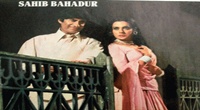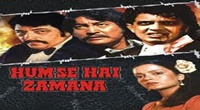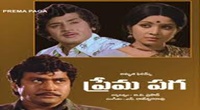This article needs additional citations for verification. (November 2017) (Learn how and when to remove this template message) |


Mah?r?ja (Sanskrit: ??????, also spelled Maharajah, Moharaja) is a Sanskrit title for a "great ruler", "great king" or "high king". A few ruled mighty states informally called empires, including Ranjit Singh, founder of the Sikh Empire, and Maharaja Sri Gupta, founder of the ancient Indian Gupta Empire, but 'title inflation' soon led to most being rather mediocre or even petty in real power, while compound titles were among the attempts to distinguish some among their ranks. Maharaja Hari Singh of Jammu and Kashmir, the largest state in British India, was the last Maharaja to be an independent sovereign post Indian independence.
The female equivalent, Maharani (or Maharanee, Moharani, Mah?r?jñ?, Maharajin), denotes either the wife of a Maharaja (or Maharana etc.), and also in states where that was customary, a woman ruling without a husband. The widow of a Maharaja is known as a Rajmata "queen mother". Maharaja Kumar generally denotes a son of a Maharaja, but more specific titulatures are often used at each court, including Yuvaraja for the heir. The form Maharaj indicates a separation of noble and religious offices, although the fact that in Hindi the suffix -a is silent makes the two titles near homophones.
Contents
Etymology
The word Maharaja originates in Sanskrit and is a compound karmadh?raya term from mah?nt- "great" and r?jan "ruler, king"). It has the Latin cognates magnum "great" and rex "king".[6] Due to Sanskrit's major influence on the vocabulary of most languages in Greater India, the term Maharaja is common to many modern languages of India such as Kannada, Tamil, Hindi, Marathi, Rajasthani, Malvi, Telugu, Odia, Punjabi, Bengali and Gujarati. The Sanskrit title Maharaja was originally used only for rulers who ruled a considerably large region with minor tributary rulers under them. Since medieval times, the title was used by (Hindu) monarchs of lesser states claiming descent from ancient Maharajas.
Indian subcontinent
|
|
|
Maharaja as a ruler's title
On the eve of independence in 1947, India (including present day Pakistan and Bangladesh) contained more than 600 princely states, each with its own native ruler, often styled Raja or Rana or Thakur (if the ruler were Hindu) or Nawab (if he were Muslim), with a host of less current titles as well.
The British directly ruled two-thirds of India; the rest was under indirect rule by the above-mentioned princes under the considerable influence of British representatives, such as Residents, at their courts.
The word Maharaja may be understood simply to mean "ruler" or "king", in spite of its literal translation as "great king". This was because only a handful of the states were truly powerful and wealthy enough for their rulers to be considered 'great' monarchs; the remaining were minor princely states, sometimes little more than towns or groups of villages. The word, however, can also mean emperor in contemporary Indian usage.
The title of Maharaja was not as common before the gradual British colonisation of India, upon and after which many Rajas and otherwise styled Hindu rulers were elevated to Maharajas, regardless of the fact that scores of these new Maharajas ruled small states, sometimes for some reason unrelated to the eminence of the state, for example, support to the British in Afghanistan, World War I or World War II. Two Rajas who became Maharajas in the twentieth century were the Maharaja of Cochin and the legendary Maharaja Jagatjit Singh of Kapurthala.
- Variations of this title include the following, each combining Maha- "great" with an alternative form of Raja 'king', so all meaning 'Great King': Maharana (as in Udaipur), Maharawal (as in Dungarpur/Jaisalmer), Maharawat (Pratapgarh), Maharao (as in Kotah, Bundi) and Maharaol (as in Baria).
- Maharajah has taken on new spellings due to the time change and migration. It has even been shortened to Mahraj and Maraj but the most common is Maharajah and Maharaj.
- Despite its literal meaning, unlike many other titles meaning Great King, neither Maharaja nor Rajadhiraja ('King of Kings'), nor even its equivalent amongst. Maharaja, 'Maharajadhiraja', never reached the standing required for imperial rank, as each was soon the object of title inflation. Instead, the Hindu title which is commonly rendered as Emperor is Samraat or Samraj(a), a personal distinction achieved by a few rulers of ancient dynasties such as the Mauryas and Guptas; the Muslim equivalent of emperor would be Padshah (of Persian origin), notably applied to the Mughal dynasty, the Paramount power until the British established their raj.
Compound and dynastic ruler titles
- Dharma-maharaja was the devout title (compare Rajadharma) of the rulers of the Ganga dynasty.
In the Mughal Empire it was quite common to award to various princes (hereditary or not) a series of lofty titles as a matter of protocolary rank. The British would, as paramount power, do the same. Many of these (see also above) elaborate explicitly on the title Maharaja, in the following descending order:
- Maharajadhiraja Bahadur (or Maharajadhiraj Bahadur): Great Prince over Princes, a title of honour, one degree higher than Maharajadhiraja.
- Maharajadhiraja (or Maharajadhiraj): Great Prince over Princes, a title of honour, one degree higher than Sawai Maharaja Bahadur.
- Sawai Maharaja Bahadur: a title of honour, one degree higher than Sawai Maharaja. (the term bahadur, originally 'brave' in Mongolian, was often used for 'one-degree' higher', and 'sawai' is 'one and a quarter higher', i.e. just a step above bahadur)
- Sawai Maharaja: a title of honour one degree higher than Maharaja Bahadur; as granted (directly) to the Rajas of Ajaygarh.
- Maharaja Bahadur: a title of honour, one degree higher than Maharaja.
Maharaja itself could also be granted as a personal; non-hereditary style, e.g. in 1941 to Sir Pratap Singh II, Raja of Ali Rajpur
Furthermore, there were various compound titles simply including other princely styles, such as :
- Maharaja Chatrapati in Satara, the paramount state of the Maratha confederacy
- H.H. the Maharaj Rana of Jhalawar
- Maharaja-i-Rajgan: great prince amongst princes
- Maharaja Sena Sahib Subah of Nagpur, another Mahratta state
- Maharaj Babu: A Rajput princely title.Used as ruling title of Hazari Estate of South Chittagong.
- For details concerning various titles containing sahib, see there
Certain Hindu dynasties even came to use a unique style, including a term which as such is not of princely rank, e.g. Maharaja Gaikwar of Baroda, Maharaja Scindia of Gwalior, Maharaja Holkar of Indore, three of the very highest ranking ruling Maratha houses.
Nobiliary and honorary use
Like Raja and various other titles, Maharaja was repeatedly awarded to notables without a princely state, such as zamindars.
- One Raja of Lambagraon, a Jagir (in Himachal Pradesh) who served in the colonial army was granted personally the non-hereditary title of Maharaja of Kangra-Lambagraon and a personal 11-guns salute, so neither honour passed on to his son and heir.
- In the major, Muslim realm of Hyderabad and Berar, there was a system of ennobling titles for the Nizam's courtiers, conferring a specific rank without any (e)state of their own, not unlike peerage titles without an actual fief in the UK, the highest titles for Hindu nobles being Maharaja Bahadur and Maharaja, above Vant, Raja Rai-i-Rayan Bahadur, Raja Rai Bahadur, Raja Bahadur, Raja and (the lowest) Rai; for their Muslim counterparts there were alternative titles, the highest being Jah and Umara; e.g. the Diwan (Prime Minister) Maharaja Sir Kishen Pershad, held such a Maharaja-title.
Derived style for princes of the blood
Maharaj Kumar (or Maharajkumar) means son of a Maharaja or Heir-Apparent; the femal
Watch movie Maharani online on Amazon
Watch movie Maharani online
Watch The Movie On PrimePrithvi Full HD Movie Download

Dil Ne Phir Yaad Kiya (2003) Full HD Movie Download
.jpg)
Do Ustaad Full HD Movie Download

Prince (1969) Full HD Movie Download
.jpg)
Qaid Mein Hai Bulbul Full HD Movie Download

Kaaboo Full HD Movie Download

Saheb Bahadur Full HD Movie Download

Rang De Basanti Full HD Movie Download

Aag(1994) Full HD Movie Download
.jpg)
Hum Se Hai Zamana Full HD Movie Download

Nishan Full HD Movie Download

Sleepy Hollow Full HD Movie Download

Eraser Full HD Movie Download

Raaj-The Showman Full HD Movie Download

Inspector Kiran Full HD Movie Download

Labaad Kuthli Full HD Movie Download

Deham Full HD Movie Download

Veta Full HD Movie Download

Prema Paga Full HD Movie Download

Terminator 2 Judgment Day Full HD Movie Download

Bunty Aur Babli Full HD Movie Download

Download latest Movie from bollywood
- 1> baaghi 3
- 2> THE SKY IS PINK MOVIE FULL STORY AND REVIEW
- 3> Luka Chuppi
- 4> TO ALL THE BOYS I’VE LOVED BEFORE
- 5> Kabir Singh
- 6> Street Dancer 3D
- 7> Simmba
- 8> Gone Girl
- 9> The Girl Who Lived
- 10> Ludo
- 11> DILWALE DULHANIA LE JAYENGE
- 12> GUILTY
- 13> The Godfather
- 14> Adventures of Rusty
- 15> Sooryavanshi
- 16> Satyameva Jayate 2
- 17> Thappad
- 18> Bhool Bhulaiyaa 2
- 19> KGFChapter 2
- 20> Mardaani 2
- 21> Pinjar
- 22> Shivaji maharaj
- 23> Ek Villian 2
- 24> Hungama 2
- 25> Divergent
- 26> Mumbai Saga
- 27> The Internship
- 28> HIT (telugu)
- 29> Panga
- 30> The perfect date
- 31> 16 December
- 32> Gopala Gopala (Telugu)
- 33> Brahmastra
- 34> Gangubai Kathiawadi
- 35> Manmadhudu
- 36> Nenu local
- 37> Mahanati
- 38> Shatamanam bavathi
- 39> Lagaan
- 40> After
- 41> MOM
- 42> Shamshera
- 43> Raguvaran BTech
- 44> Khakee
- 45> The villain
- 46> OM
- 47> Mr. perfect
- 48> Bueatifull mind
- 49> Hichki
- 50> Gabbar Singh
- 51> Jogi
- 52> Before Sunrise
- 53> Before Sunset
- 54> Before Midnight
- 55> The Big Bull
- 56> Top Gun: Maverick
- 57> The Purge
- 58> The Sky is Pink
- 59> Laxmmi Bomb
- 60> Sadak 2
- 61> Sufna
- 62> Prithviraj
- 63> PK
- 64> Coolie No 1(2020)
- 65> Black Widow
- 66> Dear Zindagi
- 67> Dil Bechara
- 68> PHIR HERA PHERI
- 69> WAR
- 70> Dostana
- 71> RRR: Roudram Ranam Rudhiram
- 72> Maidan
- 73> Dabbang 3
- 74> Chhalaang
- 75> life as we know it
- 76> SherShaah
- 77> Sandeep Aur Pinky Faraar
- 78> Event Horizon
- 79> 83
- 80> Radhe: Your Most Wanted Bhai
- 81> Gunjan Saxena: The Kargil Girl
- 82> Mr India
- 83> Vivah
- 84> Anokha Bandhan
- 85> Ghost
- 86> Bhoot: Part One - The Haunted Ship
- 87> Haseen Dilruba
- 88> Laal Singh Chaddha
- 89> Qismat
- 90> Rajput
- 91> Drive
- 92> Dil Chahta Hai
- 93> Dil Ki Baazi
- 94> Dil Ka Rishta
- 95> Teesri Manzil
- 96> Dil
- 97> Love Aaj Kal
- 98> Khaali Peeli
- 99> Bunty Aur Babli 2
- 100> Atrangi Re
- 101> Gulabo Sitabo
- 102> Jodi
- 103> Suraj Pe Mangal Bhari
- 104> Deewana
- 105> Attack
- 106> Sardar Udham Singh
- 107> Toofan
- 108> THE LOVEBIRDS
- 109> Jersey
- 110> Ginny Weds Sunny
- 111> Thalaivi
- 112> Shiddat
- 113> Angels vs Zombies
- 114> Koi Mil Gya
- 115> Thank God
- 116> Bhuj: The Pride of India
- 117> Hum Aapke Hain Kaun
- 118> The Platform
- 119> Bird Box
- 120> Roohi Afzana
- 121> Torbaaz
- 122> Nikamma
- 123> World War Z
- 124> Extraction
- 125> Train to Busan
- 126> Life of Pi
- 127> SHAADI MEIN JROOR AANA
- 128> Himmat Aur Mehnat
- 129> To All The Boys: P.S. I Still Love You
- 130> Mimi
- 131> Good Newwz
- 132> Shubh Mangal Zyada Saavdhan
- 133> Raabta
- 134> Harry Potter and the Philosopher's Stone
- 135> Harry Potter and the Chamber of Secrets
- 136> Chhapaak
- 137> War of the Worlds
- 138> Harry Potter and the Prisoner of Azkaban
- 139> Harry Potter and the Goblet of Fire
- 140> MURDER MYSTERY
- 141> Shakuntala Devi
- 142> Bachchan Pandey
- 143> Jayeshbhai Jordar
- 144> Sheer Qorma
- 145> Saina
- 146> 'O' Pushpa I hate tears
- 147> Kedarnath
- 148> MS Dhoni The Untold Story
- 149> Chhichhore
- 150> Badhaai Ho
- 151> Unstoppable
- 152> Oz the Great And Powerful
- 153> The Girl on the Train
- 154> Haathi Mere Saathi 2020
- 155> The Conjuring: The Devil Made Me Do It
- 156> Gandhi Se Pehle Gandhi
- 157> The Song of Scorpions
- 158> Srimanthudu
- 159> Hello Guru Prema Kosame
- 160> Beauty and The Beast
- 161> Black Panther
- 162> Charlie and the Chocolate Factory
- 163> Bole Chudiyan
- 164> Fidaa
- 165> Duvvada Jagannadham
- 166> Bruce Lee: The Fighter
- 167> Hyper
- 168> Yaara
- 169> Red (2020)
- 170> Shivam
- 171> That Is Mahalakshmi
- 172> Nishabdham
- 173> Aashram 2020 web series
- 174> Laxmii
- 175> Mismatched
- 176> STUDENT OF THE YEAR 2
- 177> NAIL POLISH
- 178> Ramprasad Ki Tehrvi
- 179> KAAGAZ
- 180> 12 o Clock
- 181> The Power
- 182> bolo hau
- 183> Tribhanga
- 184> JAMUN
- 185> Madam Chief Minister
- 186> Maasaab
- 187> Aadhaar
- 188> Tanhaji
- 189> Bhaagi 3
- 190> Bhootnath
- 191> MALANG
- 192> Jai Mummy Di
- 193> Haathi Mere Saathi 2021
- 194> Shakeela
- 195> Unpaused
- 196> Annayya
- 197> Vamsoddharakudu
- 198> Mrugaraju
- 199> Narasimha Naidu
- 200> Sankranti
- 201> Manasu Maata Vinadhu
- 202> Anjaane
- 203> Apaharan
- 204> Bachke Rehna Re Baba
- 205> Bewafaa
- 206> Roohi
- 207> Radhe
- 208> Zindagi Khoobsoorat Hai
- 209> Yeh Mohabbat Hai
- 210> Yeh Kya Ho Raha Hai?
- 211> The Tomorrow War
- 212> DehradunDiary
- 213> Meri Shaadi Karaoo
- 214> Matruu Ki Bijlee Ka Mandola
- 215> No One Killed Jesica
- 216> Aag Ka Goola
- 217> Eight Million Dollars
- 218> Three Hundred
- 219> Cats and Dog
- 220> Decoy
- 221> Gold Rush
- 222> You Have Got Mail
- 223> Final Destination three
- 224> Tofan
- 225> Jungle
